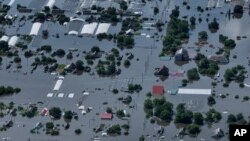On June 6, a blast destroyed a significant part of the Kakhovka dam. The dam is part of the Kakhovka Hydroelectric Power Plant (HPP), located on the Dnieper River (also called the Dnipro) in the Russian-controlled part of Ukraine’s Kherson region.
The dam’s rupture released about 18 billion cubic meters of water that flooded at least 80 Ukrainian villages and towns, causing what the United Nations called a humanitarian and environmental disaster.
Ukraine and Russia traded blame.
However, Russia’s “willful disregard for civilian life and infrastructure has been a hallmark of its military campaign,” Michael Carpenter, U.S. ambassador to the Organization for Security and Cooperation in Europe, told the Council in Vienna on June 6, calling the dam’s wrecking “an outrageous act of environmental destruction that will have profound humanitarian consequences.”
Russian officials from President Vladimir Putin to top diplomats have made false and misleading claims about the dam’s destruction, blaming it on Ukraine. Below are debunks of two leading Russian claims about the incident.
Claim #1
On June 7, Putin told Turkish President Recep Tayyip Erdogan in a phone conversation that Ukraine blew up the Kakhovka dam on instructions from its “Western curators”:
"The Kyiv authorities, at the suggestion of Western curators, continue making a dangerous bet on the escalation of hostilities. A clear example of this is the barbaric action to destroy the Kakhovskaya hydroelectric power station..."
Reporting on Putin’s accusations, RIA Novosti added that the dam ruptured after being hit with what the Russian defense ministry believed was a Ukrainian “Olkha” multiple-missile launching system, which uses guided ammunition.
Those claims are likely false.
The West condemned the destruction of the Kakhovka dam, which was fully under Russian control for more than 15 months, and the latest evidence suggests it most likely ruptured as a result of an underground explosion.
The Associated Press reported on June 8 that the drone footage from the dam did not show any evidence to back up Russia’s claims.
“The bulk of the dam itself is submerged, but the parts of buildings still visible above the rushing waters had no scorch marks or shrapnel scars typical of a bombardment that Russia has accused Ukraine of carrying out,” the AP said.
On June 9, Norway released seismic data recorded by its stations in Romania. It showed “clear signals of an explosion occurring at the Kakhovka dam” early on the morning of June 6, Reuters reported.
Earlier, Pavel Luzin, a visiting scholar at Tufts University’s Fletcher School of Law and Diplomacy, told The Financial Times that the dam’s construction, “an earth fill dam, made of compacted soil — meant it could only have been blown up from the inside and would have been left largely undamaged by artillery strikes.”
Russian troops seized the Kakhovka Hydroelectric Power Plant on February 24, 2022, the first day of Moscow’s full-scale invasion of Ukraine. Since then, they have controlled the facility and the nearby city of Nova Kakhovka.
CLAIM #2
On June 7, Russian Ambassador to Germany Sergei Nechaev stated that there was no evidence Russia destroyed the Kakhovka dam:
"We paid attention to the statements of German politicians, media reports in which the responsibility for the destruction of the dam of the Kakhovskaya hydroelectric power station is categorically assigned to Russia. We are outraged by speculation ..."
That statement is false: there are reasonable grounds to believe that Russia blew up the dam.
“The United States government has intelligence that is leaning towards Russia as the culprit of the attack on the dam in Ukraine,” NBC News reported on June 6, citing “two U.S. officials and one Western official.”
“President Joe Biden’s administration was working to declassify some of the intelligence,” NBC said.
On June 7, the Kherson region’s Russian-appointed governor, Volodymyr Saldo, said that destroying the dam benefited the Russian troops that control the southern part of the region:
"From the point of view of the military, the operational-tactical situation has now developed in favor of the Armed Forces of the Russian Federation."
The Institute for the Study of War (ISW) wrote in its October 2022 forecast that Russia had "a greater and clearer interest in flooding the lower Dnipro despite the damage to their own prepared defensive positions and forces than the Ukrainians.”
More recently, on June 6, the ISW wrote:
“Russia may use the flooding to widen the Dnipro River and complicate Ukrainian counteroffensive attempts across the already-challenging water feature. Russian sources have expressed intense and explicit concern over the possibility that Ukraine has been preparing to cross the river and counterattack into the east bank of Kherson Oblast.”
Back on October 20, 2022, Ukrainian President Volodymyr Zelenskyy said Russian troops had mined the Kakhovka dam and hydroelectric power plants.
“Russia is deliberately creating the grounds for a large-scale disaster in the south of Ukraine," Zelenskyy said.
There is also history.
The Soviet army used similar tactics during WWII. While retreating from eastern Ukraine, Soviet forces blasted a massive hole in the Dnipro hydroelectric station’s dam, and thousands of civilians died in the ensuing flooding. Radio Free Europe/Radio Liberty cited a survivor of that incident as saying, "all night there were cries for help, cows were swimming and mooing and people were climbing trees. There was no one to save (the) people."





